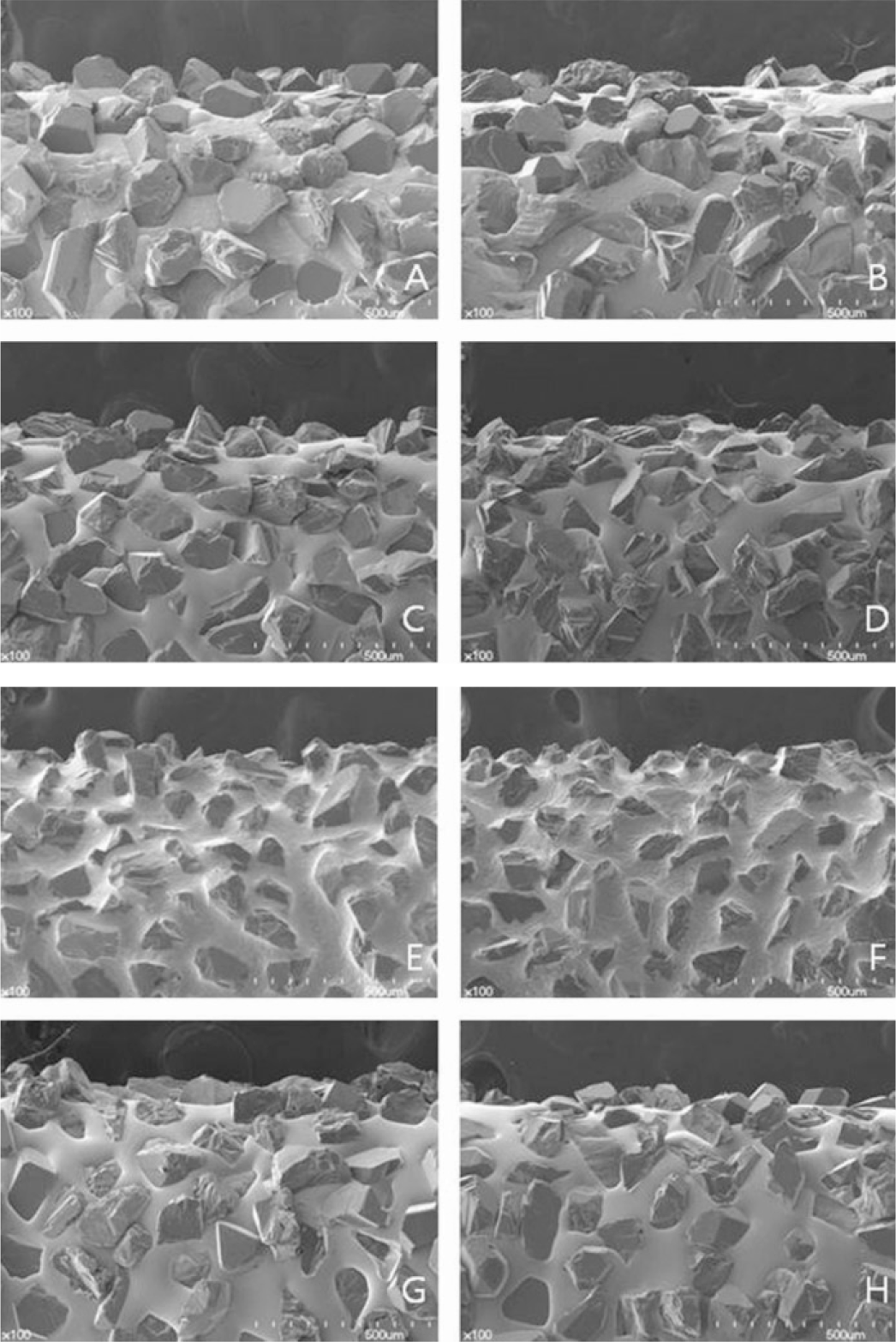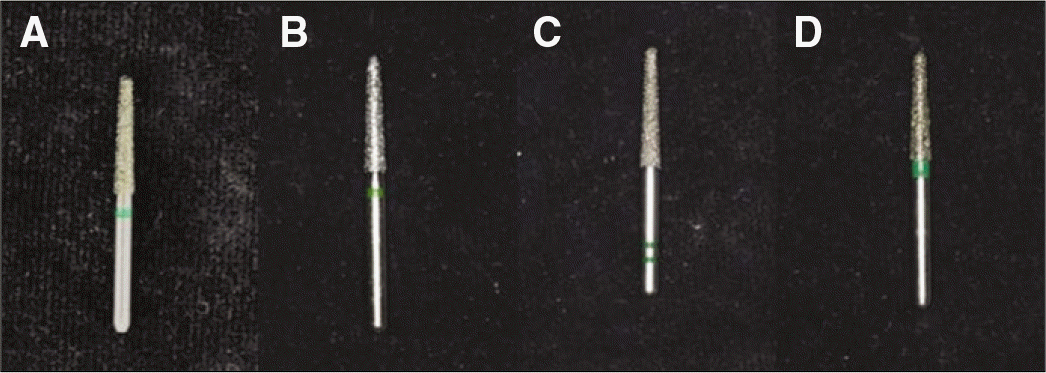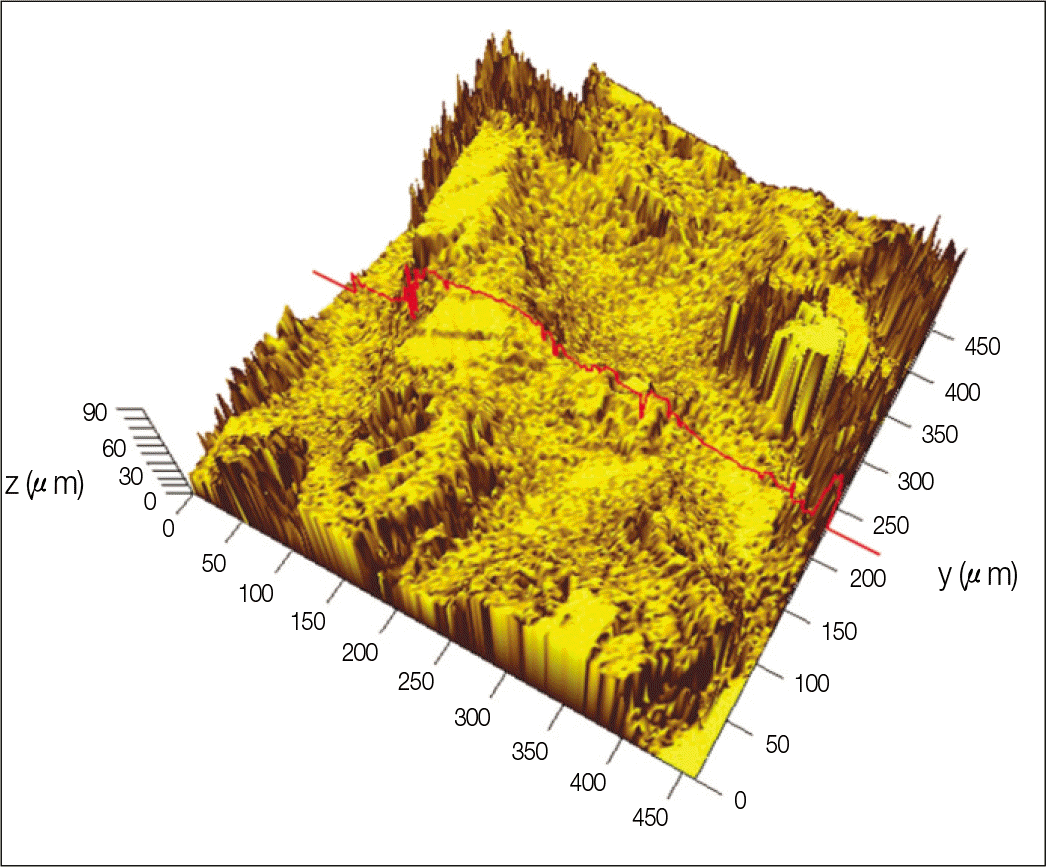Abstract
Purpose
The purpose of this study was to investigate the cutting efficiency of coarse grit diamond burs with air-turbine handpiece on natural tooth.
Materials and methods
Four groups of coarse grit diamond bur were selected: Komet (A), Shofu (B), Premier (C), and Mani (D). The extracted maxillary central incisors were used, and ten cuts were made on each specimen, using the rotary diamond burs. The surface of each bur was measured at the upper, middle, and bottom of the bur with confocal laser scanning microscope and imaged with SEM. The data were analyzed with one-way ANOVA and t-test at the significance level of 0.05.
Results
The surface roughness was measured. At the A diamond bur, the Sa values were 52.93 μ m, 48.32 μ m, 46.79 μ m, 45.06 μ m, and 43.43 μ m for control, test 1, 2, 3, and 4 respectively. The Sa values were 50.68 μ m, 45.62 μ m, 44.41 μ m, 44.10 μ m, and 42.46 μ m for B diamond bur, 58.02 μ m, 55.53 μ m, 52.22 μ m, 48.26 μ m, and 45.36 μ m for C diamond bur, and 50.11 μ m, 46.73 μ m, 45.46 μ m, 42.58 μ m, and 41.80 μ m for D diamond bur. Surface roughness after each bur use showed significant changes, but no significant difference was found in surface roughness change between bur systems.
Conclusions
Surface roughness in the same bur system showed significant differences after each tooth preparation. However no statistically significant differences were found in surface roughness between bur systems. The SEM images between control and test 4 showed the abraded particles. (J Korean Acad Prosthodont 2011;49:1-7)
Go to : 
REFERENCES
1.de Tomasi A. History of the evolution of diamond burs in dentistry. Odontostomatol Implantoprotesi. 1976. 2:72–4.
2.Siegel SC., Von Fraunhofer JA. Dental cutting: the historical development of diamond burs. J Am Dent Assoc. 1998. 129:740–5.

3.Watson TF., Flanagan D., Stone DG. High and low torque handpieces: cutting dynamics, enamel cracking and tooth temperature. Br Dent J. 2000. 188:680–6.

4.Dyson JE., Darvell BW. The present status of dental rotary cutting performance tests. Aust Dent J. 1995. 40:50–60.

5.Siegel SC., von Fraunhofer JA. Assessing the cutting efficiency of dental diamond burs. J Am Dent Assoc. 1996. 127:763–72.

6.Siegel SC., von Fraunhofer JA. Effect of handpiece load on the cutting efficiency of dental burs. Mach Sci Technol. 1997. 1:1–13.

7.Galindo DF., Ercoli C., Funkenbusch PD., Greene TD., Moss ME., Lee HJ., Ben-Hanan U., Graser GN., Barzilay I. Tooth preparation: a study on the effect of different variables and a comparison between conventional and channeled diamond burs. J Prosthodont. 2004. 13:3–16.

8.Janota M. Use of scanning electron microscopy for evaluating diamond points. J Prosthet Dent. 1973. 29:88–93.

9.Corning Inc. Macor machinable glass ceramic data (specifications bulletin). Corning, NY: Corning Inc.;1994. p. 1–7.
11.Price RB., Sutow EJ. Micrographic and profilometric evaluation of the finish produced by diamond and tungsten carbide finishing burs on enamel and dentin. J Prosthet Dent. 1988. 60:311–6.

12.Eames WB., Nale JL. A comparison of cutting efficiency of air-driven fissure burs. J Am Dent Assoc. 1973. 86:412–5.

13.Semmelman JO., Kulp PR., Kurlansik LR. Cutting Studies at Air-Turbine Speeds. J Dent Res. 1961. 40:404–10.

Go to : 
 | Fig. 3.SEM photomicrographs of coarse grit diamond bur at × 100 magnification. A: before use of A diamond bur, B: after four times of A diamond bur, C: before use of B diamond bur, D: after 4 use of B diamond bur, E: before use of C diamond bur, F: after 4 use of C diamond bur, G: before use of D diamond bur, H: after 4 use of D diamond bur. |
Table 1.
Characteristics of diamond burs; information produced by manufacturers
Table 2.
Surface roughness (μ m) of A coarse grit diamond bur
| Control | Test 1 | Test 2 | Test 3 | Test 4 | |
|---|---|---|---|---|---|
| Upper | 18.81 | 18.04 | 15.67 | 16.11 | 14.56 |
| Middle | 16.65 | 15.21 | 16.03 | 15.52 | 14.69 |
| Bottom | 17.47 | 15.07 | 15.09 | 13.43 | 14.18 |
Table 3.
Surface roughness (μ m) of B coarse grit diamond bur
| Control | Test 1 | Test 2 | Test 3 | Test 4 | |
|---|---|---|---|---|---|
| Upper | 16.84 | 15.48 | 13.67 | 14.67 | 13.58 |
| Middle | 17.01 | 14.66 | 15.56 | 14.71 | 15.13 |
| Bottom | 16.83 | 15.48 | 15.18 | 14.72 | 13.75 |
Table 4.
Surface roughness (μ m) of C coarse grit diamond bur
| Control | Test 1 | Test 2 | Test 3 | Test 4 | |
|---|---|---|---|---|---|
| Upper | 18.36 | 17.10 | 17.21 | 15.96 | 15.35 |
| Middle | 19.44 | 18.73 | 17.35 | 14.86 | 14.38 |
| Bottom | 20.22 | 19.70 | 17.66 | 17.44 | 15.63 |




 PDF
PDF ePub
ePub Citation
Citation Print
Print




 XML Download
XML Download